By: Byron Mathioudakis
For SUV fans who are considering the move to a regular or plug-in hybrid, while you're still not spoilt for choice yet in Australia, there are certainly a healthy number of options and the range continues to grow.
To help you narrow down the choices, we've reviewed the full range of plug-in hybrid electric SUVs (PHEV) on offer in Australia in 2022, to help you decide if moving to a PHEV is the right choice.
In these reviews we cover SUVs that are plug-in hybrids. For a run down of other SUVs that are regular hybrids (not plug-ins), check our reviews of Hybrid cars available in Australia 2022.
To find out more about the differences between regular hybrids and plug-in hybrids, see our Hybrid Cars Explained guide.
MG HS Plus EV PHEV from $46,990 driveaway
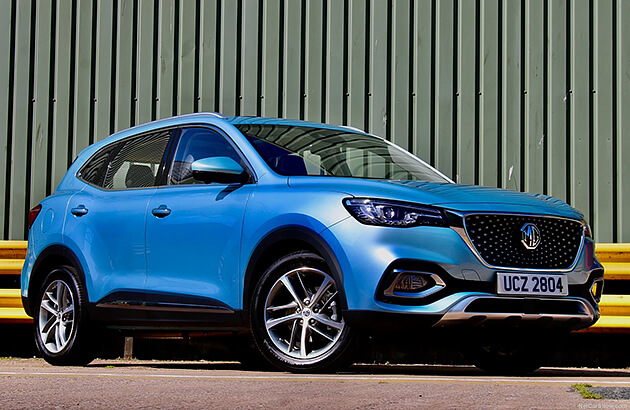
Don’t be deceived by the name. The HS Plus EV is MG-speak for plug-in hybrid, not a pure electric vehicle.
About the size of the Mazda CX-5 that so clearly inspired the styling, the HS is an attractively designed medium-sized SUV offering plenty of space, lots of practical features and a big boot, measuring in at a handy 451 litres.
Aimed at the Mitsubishi Eclipse Cross and Ford Escape plug-in hybrids, the HS PHEV is also one of the more powerful, using a gutsy 1.5-litre turbo petrol engine to drive the front wheels, alongside an electric motor and battery pack. The 0-100km/h acceleration time is a speedy 6.9 seconds. Pure EV range is available for around 50km, before the engine kicks in.
Once the battery is depleted, it can be replenished using a regular home socket overnight, or in around 2.5 hours plugged into an optional wall box/AC charger.
One change for 2022 is the introduction of a lower-specified grade, the Excite. It still includes features like a digital instrument cluster, heated front seats and dual-zone climate control, but you’ll now need to buy the more expensive Essence for LED headlights, a powered tailgate, 360-degree camera, panoramic sunroof and ambient lighting.
The HS remains one of Australia’s cheapest PHEVs.
| Engine: | 119kW/250Nm 1.5L in-line 4 petrol turbo |
|---|---|
| Transmission/driving wheels: | 10-speed auto/FWD |
| Motor: | 90kW/230Nm permanent magnet synchronous |
| Battery: | 16.6kWh Lithium ion |
| Total system power/torque: | 187kW/370Nm |
| EV range: | 52km |
| Fuel: | 1.7L/100km |
| CO2: | 39g/km |
| Safety rating: | N/A |
Mitsubishi Eclipse Cross PHEV AWD from $46,990 plus on-road costs
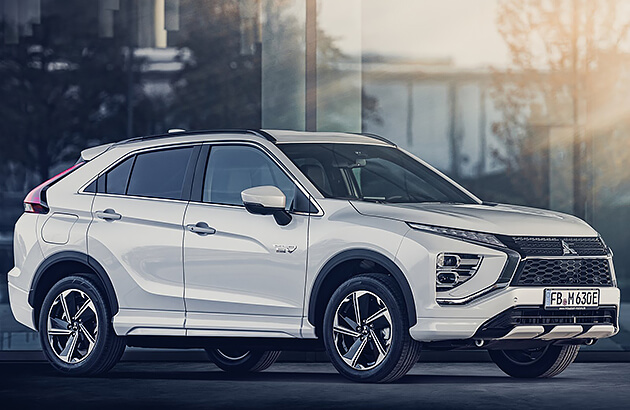
The Mitsubishi Eclipse Cross PHEV is the smaller SUV brother to the highly-successful Outlander PHEV.
Along with a 2.4-litre petrol engine, it features an electric motor located on both axles and a large 13.8kWh battery.
Three driving modes are offered. EV Priority alone uses the electric motors, with a maximum 55km range before the petrol engine kicks in; Series Hybrid mode has the electric motors driving the wheels but the petrol engine charges the battery pack; and Parallel Hybrid mode has the petrol engine driving the front wheels with electric motor assistance, and is usually reserved for higher speeds. The front electric motor always drives the PHEV off the line regardless of mode.
Charging the battery takes six hours with a regular household plug, 4.5 hours with an optional wall box or just 30 minutes at a DC charging station, or, alternatively, about 45 minutes having the petrol engine running whilst parked. Note that bi-directional (V2H/V2G) charging is also supported when the required infrastructure catches up in Australia.
Built in Japan, the Eclipse Cross PHEV is compact yet roomy enough for a small family, with an inviting and comfortable cabin, enjoyable handling and plenty of practical features. It also offers Mitsubishi’s unbeatable 10-year conditional warranty.
| Engine: | 94kW/199Nm 2.4L in-line 4 petrol |
|---|---|
| Transmission/driving wheels: | CVT auto/AWD |
| Motor: | 60kW/137Nm AC permanent magnet synchronous (front) / 70kW/195Nm AC permanent magnet synchronous (rear) |
| Battery: | 13.8kWh Lithium ion |
| Total system power/torque: | 157kW/332Nm |
| EV range: | 55km |
| Fuel: | 1.9L/100km |
| CO2: | 43g/km |
| Safety rating: | 5 stars |
Ford Escape ST-Line PHEV from $54,440 plus on-road costs
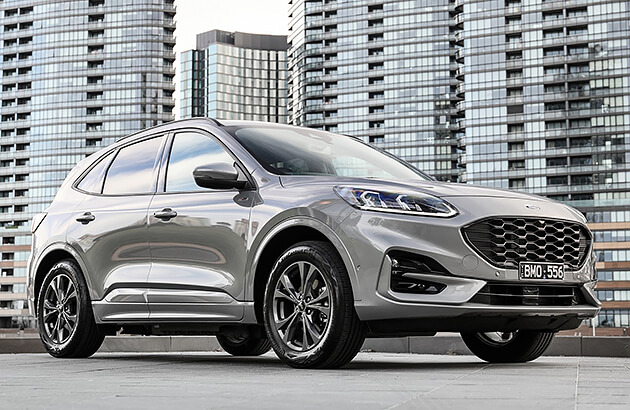
After lengthy delays, the Escape ST-Line plug-in hybrid from Spain is finally here to give the Mitsubishi Outlander some serious competition.
Under the bonnet is a 2.5-litre petrol engine mated to a continuous variable transmission (CVT auto), electric motor and battery pack, to deliver a total of 167kW on one hand, and a combined fuel economy figure of just 1.5L/100km on the other.
Ford reckons up to 56km of pure-EV range is available, though in real-world scenarios that’s probably closer to 35km, with the driver able to choose when to deploy battery-only drive according to conditions.
About six hours is required to replenish the battery pack at home, or nearly four hours using an optional wall box or AC public charger.
Along with distinctive styling, the Escape is also well packaged inside, offering plenty of space and versatility for the family, along with a big, useable boot.
Being an ST-Line means the steering, handling and roadholding capabilities are on the sportier side for a high-riding medium-sized SUV, making the Ford stand out against its more eco-orientated rivals.
Which is what may attract buyers to the Escape PHEV. It’s good to look at and fun to drive, as well as fairly quick, while still being very economical.
| Engine: | 112kW 2.5L in-line 4 petrol |
|---|---|
| Transmission/driving wheels: | CVT/front |
| Motor: | 96kW AC synchronous electric |
| Battery: | 14.4kWh lithium-ion |
| Total system power/torque: | 167kW |
| EV range: | 56km |
| Fuel: | 1.5L/100km |
| CO2: | 33g/km |
| Safety rating: | 5 stars |
Mitsubishi Outlander PHEV AWD from $54,590 (approximately)
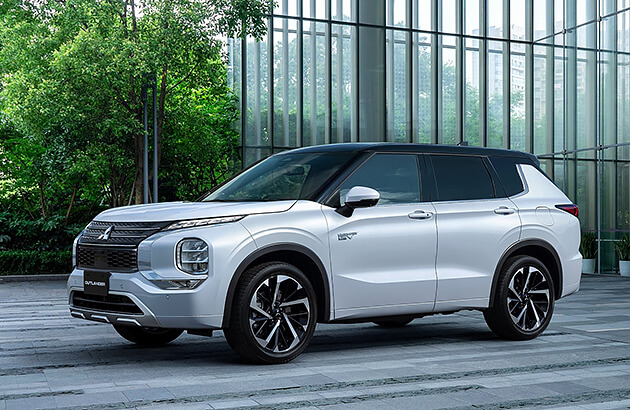
The previous Mitsubishi’s Outlander PHEV became Australia’s first mainstream plug-in hybrid.
Now, an all-new version is coming late in 2022, built on the equally-fresh Nissan X-Trail-based platform, and bringing a seven-seater layout option for the first time.
There’s no mistaking the differences, due to the bigger and far-bolder styling up front, resulting in a larger, roomier and more practical interior. The dash also seems generations ahead, with massive digital displays, while cargo capacity is huge.
Under the bonnet is an improved 2.4-litre petrol engine driving the front wheels via a continuously variable transmission, boosted by two electric motors, with the rear one providing all-wheel drive.
As before, Outlander PHEV drivers will be able to cycle between several driving modes, from EV-only to hybrid to petrol-only, but with dramatically increased electric range than before, up 53 per cent to about 84km, thanks to a larger battery.
Charging times are expected to increase, inevitably, to around eight hours from a household plug, about five hours using an optional wall box and under an hour employing a DC public charger. Of course, the petrol engine in charge mode can also replenish the battery on the go.
Economical and practical for growing families, the new Outlander PHEV should be a leading contender.
| Engine: | 98kW/195Nm 2.4L in-line 4 petrol* |
|---|---|
| Transmission/driving wheels: | CVT auto/AWD |
| Motor: | 85kW/255Nm AC synchronous electric (front)* / 100kW/195Nm AC synchronous electric (rear)* |
| Battery: | 20kWh lithium-ion |
| Total system power/torque: | 157kW/332Nm* |
| EV range: | 84km* |
| Fuel: | 1.6L/100km* |
| CO2: | 38g/km* |
| Safety rating: | 5 stars |
* overseas data
Cupra Formentor PHEV from $60,990 plus on-road costs
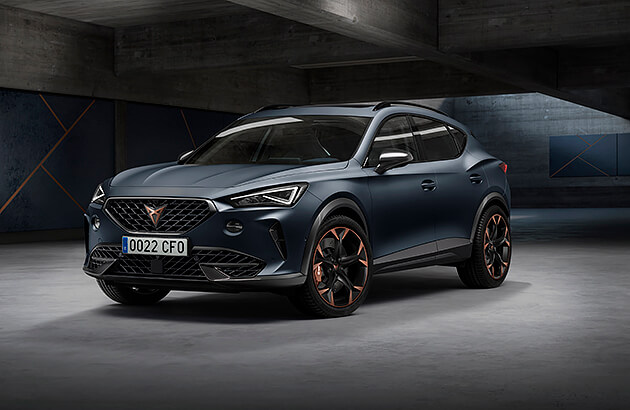
Look out, Mercedes-Benz GLA, Audi Q3, BMW X2 and Volvo XC40 – the Cupra Formentor is here.
Based on the same architecture that underpins the Volkswagen Golf, the Cupra is Volkswagen’s Spanish subsidiary SEAT’s high-performance offshoot, so think of the Formentor as a sporty, raised hatchback/crossover with VW tech. Yet the plug-in hybrid powertrain specification is so far unique to the Cupra.
We’re talking about a 1.4-litre turbo-petrol engine, dual-clutch transmission, an electric motor and small battery pack, driving the front wheels only. Real-world pure-EV range is under 50km. But performance is brisk, the steering is sharp and the ride quite firm, highlighting the Spanish VW’s sporty flavour.
Like most PHEVs, the Formentor can only be charged using an AC outlet, and it needs about six hours using a home socket, or about half that if you invest in a wall box charger.
The interior is appealing, with decent space front and rear, a slick dashboard featuring a large touchscreen, electronic displays and plenty of standard features, though the boot isn’t as big as the crossover styling promises.
As a stylish and very economical crossover-coupe with Golf-derived engineering and a driver-orientated focus, the Cupra Formentor PHEV is in a niche of its own for now.
| Engine: | 110kW/250Nm 1.4L in-line 4 turbo petrol |
|---|---|
| Transmission/driving wheels: | 6-speed DCT/FWD |
| Motor: | 85kWh AC synchronous electric |
| Battery: | 12.8kWh Lithium-ion |
| Total system power/torque: | 180kW/400Nm |
| EV range: | 52km* |
| Fuel: | 1.9L/100km |
| CO2: | 43g/km |
| Safety rating: | 5 stars |
* Overseas data
Mini Countryman SE ALL4 PHEV AWD from $64,000 plus on-road costs
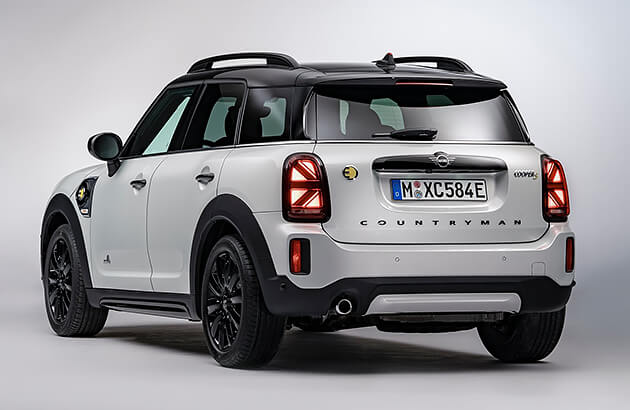
The BMW-owned British brand forged fresh pathways in 2019 with the Countryman SE plug-in hybrid, combining a 1.5-litre turbo engine driving the front wheels, backed up by an electric motor turning the rear wheels. Like Toyota’s e-Four set-up, with the rear drive part of the drive system being electric, there is no mechanical link to the petrol engine.
Late 2020 brought a raft of improvements, including over 60km of electric-only drive, before the engine takes over.
In Mini-speak, the ‘S’ in the name signifies performance, meaning the PHEV streaks to 100km/h in 6.8 seconds, beating the normal Cooper S. Similarly-responsive steering and kart-like handling feel are also largely maintained. Because of the battery’s comparatively small size, charging requires 3.5 hours at home, or an hour faster with an optional wall box.
As with other BMW PHEVs, a ‘Save Battery’ mode redirects braking energy to keep the battery at 90 per cent constantly – great for saving EV drive when not needed. The lofty pricing brings with it generous standard equipment, and the Mini’s playful yet premium cabin presentation is retained. There’s sufficient space for smaller families’ needs, and cargo capacity drops slightly, from 450L to 405L.
Overall, the polished Countryman PHEV keeps the Mini’s fun charm, but with newfound electrified capability.
| Engine: | 100kW/220Nm 1.5L in-line 3 turbo petrol |
|---|---|
| Transmission/driving wheels: | 6-speed auto/AWD |
| Motor: | 70kW/165Nm AC synchronous electric |
| Battery: | 9.6kWh Lithium-ion |
| Total system power/torque: | 165kW/385Nm |
| EV range: | 50km |
| Fuel: | 2.4L/100km |
| CO2: | 54g/km |
| Safety rating: | 5 stars |
Kia Sorento PHEV AWD from $80,330
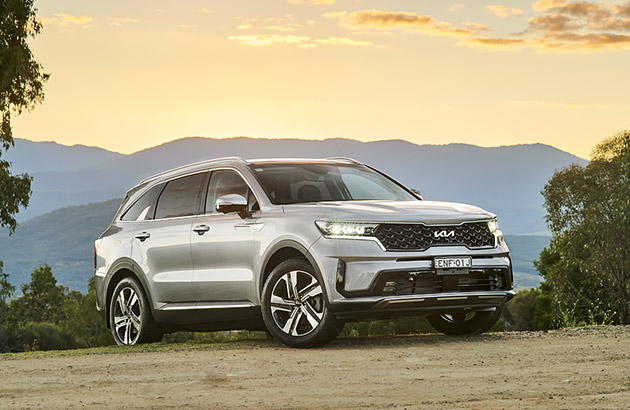
Alongside the new Kia Niro plug-in, the Sorento GT-Line PHEV is one of two plug-in hybrids currently in Kia’s range.
The Sorento GT-Line PHEV is the most expensive version of the completely redesigned, full-sized, seven-seater SUV released in 2020.
It features a 1.6-litre turbo-petrol engine and six-speed auto, combined with an electric motor. Along with smooth and seamless transition from petrol to hybrid to EV, there’s also nearly 60km of pure electric drive.
For a large seven-seater, the Sorento PHEV possesses plenty of muscle (0-100km/h needs just 8.4 seconds), with a healthy dose of electric-enhanced power available for instant throttle response, backed up by light steering and surefooted cornering.
Charging at home using a regular socket should take about six hours, or around 3.5 hours with an optional wall box fitted to your garage or at work. As with many PHEVs, charging is AC only, so DC fast chargers can’t be used.
Besides being a great size for transporting seven people, the latest Sorento is beautifully designed and finished inside. The PHEV is only available in top-line GT-Line spec, bringing massive touchscreens, lovely materials and luxury car levels of interior detailing. And all supported by a seven-year warranty.
It’s a lot of money, but you do get a lot of car, too.
| Engine: | 132kW/165Nm 1.6L in-line 4 petrol turbo |
|---|---|
| Transmission/driving wheels: | six-speed auto/AWD |
| Motor: | 67kW/304Nm AC permanent magnet synchronous |
| Battery: | 13.8kWh Lithium ion |
| Total system power/torque: | 195kW/350Nm |
| EV range: | 68km |
| Fuel: | 1.6L/100km |
| CO2: | 36g/km |
| Safety rating: | 5 stars |
Lexus NX 450h+ AWD PHEV from $80,330
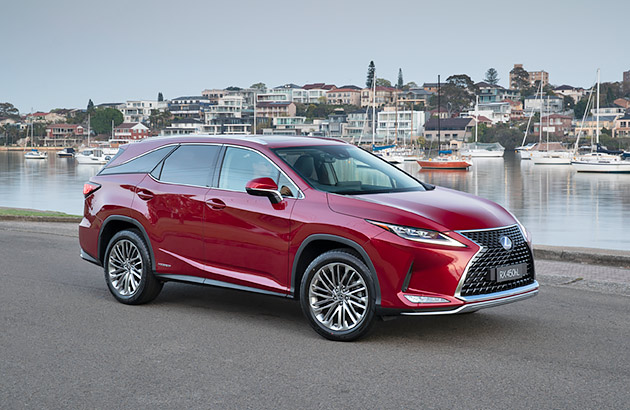
Lexus’ first plug-in hybrid in Australia is based on the second-generation NX and is aimed at the BMW X3 and Mercedes-Benz GLC PHEVs.
Even though it appears similar to the old NX released in 2014, today’s version is longer, larger and completely redesigned inside and underneath, adopting an advanced new architecture that aims to be stronger, quieter and more refined than before.
The latter is evident in the NX 450h+’s smooth power delivery, thanks to a 2.5-litre petrol engine and continuously variable transmission, working seamlessly with an electric motor and battery pack. Performance is rapid, with a 0-100km/h time of just 6.3 seconds, while up to 87km of pure EV range is promised – one of the highest among all PHEVs – if the driver is light-footed enough.
You can recharge the battery in around 12 hours using a normal home socket, 7.5 hours plugged into a wall box/AC charger or under three hours using a DC rapid charger – though Lexus recommends “minimising” the latter to maximise battery life.
Enjoyable to drive, strikingly styled, beautifully made with high quality materials and plenty of standard equipment, and offering industry-leading levels of available aftersales service and ownership benefits, the NX 450h+ from Japan is now one of Australia’s more compelling luxury plug-in hybrids.
| Engine: | 136kW/227Nm 2.5L in-line 4 petrol |
|---|---|
| Transmission/driving wheels: | e-CVT/AWD |
| Motor: | 134kW/270Nm AC permanent magnet synchronous |
| Battery: | 18.1kWh Lithium ion |
| Total system power/torque: | 227kW |
| EV range: | 87km |
| Fuel: | 1.3L/100km |
| CO2: | 29g/km |
| Safety rating: | 5 stars |
Peugeot 3008 PHEV AWD from $84,790 plus on-road costs
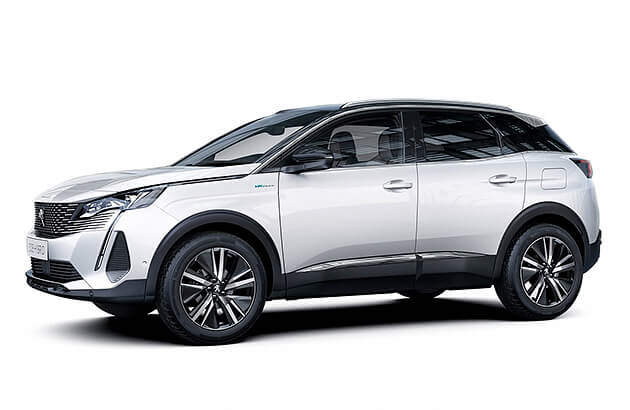
Peugeot has been selling plug-in hybrids overseas for over a decade now, but they’ve only recently arrived in Australia.
Aimed at German midsized SUV rivals like the BMW X3 xDrive30e, the 3008 GT Sport PHEV helps justify its lofty pricing with a powerful 1.6-litre four-cylinder turbo petrol engine, combined with an eight-speed auto and two electric motors (one on each axle) for all-wheel drive.
The result is nearly 60km of pure EV range, as well as a 0-100km/h sprint time in a very healthy 5.9 seconds, on the way to a 235km/h top speed. That’s fast.
To recharge at home using a regular socket requires nearly six hours. Alternatively, buying an optional wall box will cut that down to under four hours. Note the 3008 PHEV doesn’t accept DC fast chargers.
Being based on the top-line GT Sport grade, the French crossover is fully equipped on both the safety and convenience front, and even includes massaging front seats.
On sale since 2017, the 3008 resurrected Peugeot’s fortunes globally based on head-turning design, high-end interior presentation, excellent driving capabilities and a massive step up in quality engineering. The 2021 facelift ushered in fresh styling changes, improved safety and an upgraded multimedia system, further boosting the SUV’s appeal.
| Engine: | 147kW/300Nm 1.6L in-line 4 turbo petrol |
|---|---|
| Transmission/driving wheels: | 81kW AC synchronous electric (front) / 83kW AC synchronous electric (rear) |
| Motor: | 134kW/270Nm AC permanent magnet synchronous |
| Battery: | 13.2kWh lithium-ion |
| Total system power/torque: | 222kW/520Nm |
| EV range: | 60km |
| Fuel: | 1.6L/100km |
| CO2: | 36g/km |
| Safety rating: | 5 stars |
Mercedes-Benz GLC 300e 4Matic AWD from $95,700 plus on-road costs
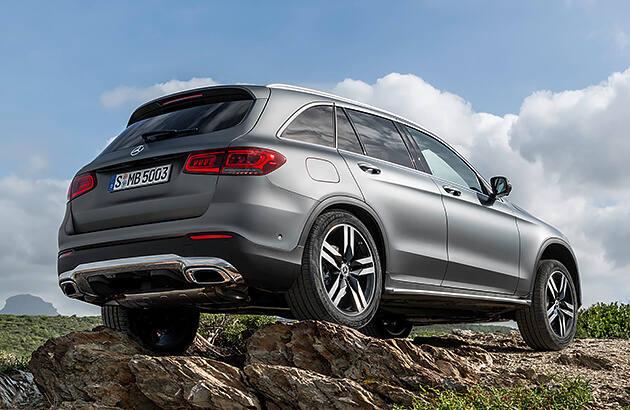
Massively popular, the GLC went plug-in hybrid in 2020, rivalling the BMW X3 xDrive30e.
Like its closely related C300e sibling, the medium-sized SUV brings together a 2.0-litre turbo engine, but with the nine-speed auto driving all four wheels this time.
Boosted by an electric motor and battery, the outcome is stirring performance (0-100km/h needs only 5.7 seconds), backed up by easy and confident handling control.
Plus, there’s nearly 50km of pure-electric range available. When that runs out, you’ll need about seven hours to recharge the battery pack at home, or around three hours using an optional wall box/public AC charger.
Buyers love the GLC because its interior is smooth and stylish, though the striking single-screen multimedia interface of newer Mercedes models like the latest C-Class isn’t fitted, betraying this generation SUV’s advancing years.
Along with firm but supportive seating and plenty of storage areas, there’s space galore both up front and in the back, but the small 395L cargo capacity is down 155L due to the battery gubbins underneath.
As expected, a full suite of driver-assist safety is included, along with air suspension that addresses the regular GLC’s at-times uncomfortable ride.
An all-new generation GLC is coming in 2023, with improved PHEV versions. We’d wait for those instead.
| Engine: | 155kW/350Nm 2.0L in-line 4 turbo petrol |
|---|---|
| Transmission/driving wheels: | 9-speed auto/AWD |
| Motor: | 90kW/440Nm AC synchronous electric |
| Battery: | 13.5kWh Lithium-ion |
| Total system power/torque: | 235kW/700Nm |
| EV range: | 49km |
| Fuel: | 2.4L/100km |
| CO2: | 53g/km |
| Safety rating: | 5 stars |
Volvo XC60 Recharge PHEV AWD from $97,990 plus on-road costs
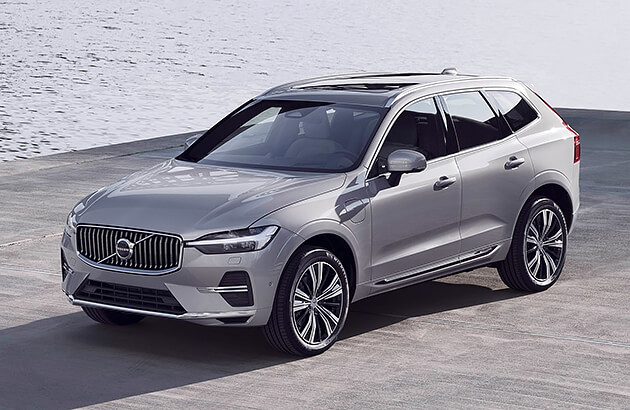
Volvo released a facelifted XC60 in late 2021.
Previously called T8 Polestar Engineered but now known as the Recharge Plug-in Hybrid, it looks more restrained than before, and also brings worthwhile improvements, including nearly double the electric range (to 81km) thanks to a much bigger battery. Look out, BMW X3 xDrive30e.
As before, a 2.0-lite supercharged and turbocharged petrol engine drives the front wheels via an eight-speed automatic, while a rear-mounted electric motor adds all-wheel-drive. Volvo has managed to make its latest PHEV faster as well as more efficient, dropping the 0-100km/h time to a hasty 4.8 seconds.
This is a rapid and fun-to-drive midsized luxury SUV, with reassuring handling and a comfy ride due to air suspension that can be tailored for agility or softness.
When the battery depletes, you’ll need up to eight hours to recharge it at home using a regular plug, or over four hours with an optional wall box/AC public charger. DC fast charging is not supported.
For 2022, the latest XC60 gains an integrated Google multimedia system (but no Apple CarPlay/Android Auto yet), while the spacious and practical interior retains a particular Swedish flavour that melds solidity and sensible functionality.
All XC60s for the Australian market are now built in China.
| Engine: | 233kW/400Nm 2.0L in-line 4 turbo/supercharged petrol |
|---|---|
| Transmission/driving wheels: | 8-speed auto/AWD |
| Motor: | 107W AC synchronous electric |
| Battery: | 18.8kWh Lithium-ion |
| Total system power/torque: | 340kW |
| EV range: | 81km |
| Fuel: | 1.6L/100km |
| CO2: | 37g/km |
| Safety rating: | 5 stars |
Range Rover Evoque P300e PHEV AWD from $102,001 plus on-road costs
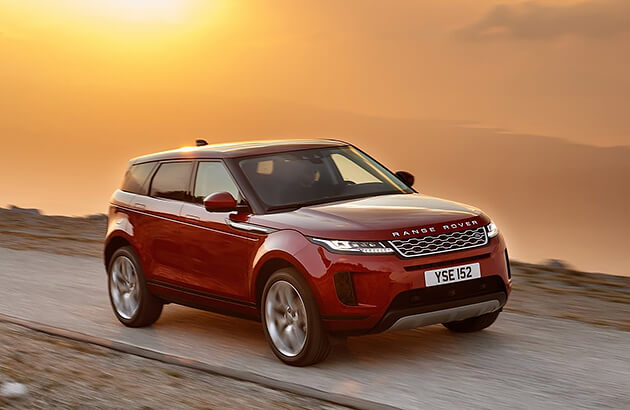
Launched in early 2022, the Range Rover Evoque P300e is the midsized SUV’s first plug-in hybrid offering.
Under the svelte bonnet is a new 1.5-litre three-cylinder turbo petrol engine and eight-speed auto, paired with a rear-mounted electric motor and battery pack. The upshot is approximately 60km of pure-EV range on one hand, and a rapid 6.3-second 0-100km/h sprint-time on the other. This Evoque doesn’t hang around.
Speaking of which, recharging using a household plug requires around six hours, or under 2.5 hours with an optional wall box. The Evoque PHEV is also DC fast-charger compatible, needing about 50 minutes.
Along with being quick and easy to drive on road, the English midsized SUV offers some decent off-road capability as well, aided by good ground clearance and some electronic 4x4 technology. It is built by Land Rover of England, after all.
There’s a plenty of space inside the slickly presented Evoque, backed up by a handy 472-litre cargo capacity. High quality fittings, a bang-up-to-date multimedia system, and a litany of driver-assist safety systems are also included in the P300e.
The Evoque P300e promises to be glamourous and rewarding to drive, but consumers should be aware that the brand has been lumbered with reliability issues in recent years.
But the Evoque P300e does have some off-road prowess, and fills the role of an eco-focused premium midsized crossover.
| Engine: | 147kW/280Nm 1.5L in-line 3 turbo petrol |
|---|---|
| Transmission/driving wheels: | 8-speed auto/AWD |
| Motor: | 85kW AC synchronous electric |
| Battery: | 15.0kWh lithium-ion |
| Total system power/torque: | 227kW/540Nm |
| EV range: | 62km |
| Fuel: | 2.1L/100km |
| CO2: | 32g/km |
| Safety rating: | 5 stars |
BMW X3 xDrive30e PHEV AWD from $104,900 plus on-road costs
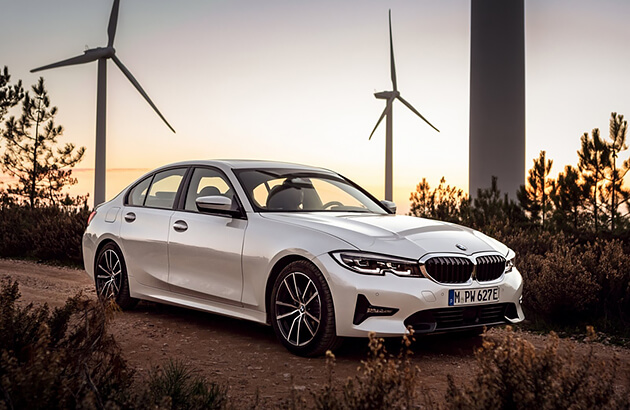
It’s taken years to get here, but the X3 plug-in hybrid is finally available in Australia.
Slotting between the regular petrol and diesel X3 models and the battery-powered iX3 from China, the US-built PHEV shares much of its tech with the related 330e sedan on sale here since 2020. This means a 2.0-litre petrol turbo and eight-speed auto married to an electric motor and small battery pack.
Along with being a wagon-style medium-sized SUV offering ample space for five people, rather than a swoopy sports sedan, a key difference is that the ‘x’ in xDrive30e denotes all-wheel drive, bringing better all-weather roadholding.
Unsurprisingly, the X3 PHEV offers strong acceleration (0-100km/h in just 6.1 seconds), or about 40km of pure-electric range if you’re driving gingerly, especially around town. Combined electric consumption is 19.3kWh/100km.
A household socket requires around seven hours to fully recharge the battery, or half that time with an optional (circa-$2000) wall box at home or work.
Another benefit of using a high-riding SUV is the extra space under the floor to package the battery, meaning that cargo capacity remains the same as all other X3s at 450 litres.
If you’re looking for a pure electric experience, consider the iX3 instead. BMW claims 460km between recharges is possible.
| Engine: | 135kW/300Nm 2.0L in-line 4 turbo petrol |
|---|---|
| Transmission/driving wheels: | 8-speed auto/AWD |
| Motor: | 83kW AC synchronous electric |
| Battery: | 12kWh Lithium-ion |
| Total system power/torque: | 215kW/420Nm |
| EV range: | 41km |
| Fuel: | 3.2L/100km |
| CO2: | 73g/km |
| Safety rating: | 5 stars |
Volvo XC90 Recharge PHEV from $118,990 plus on-road costs
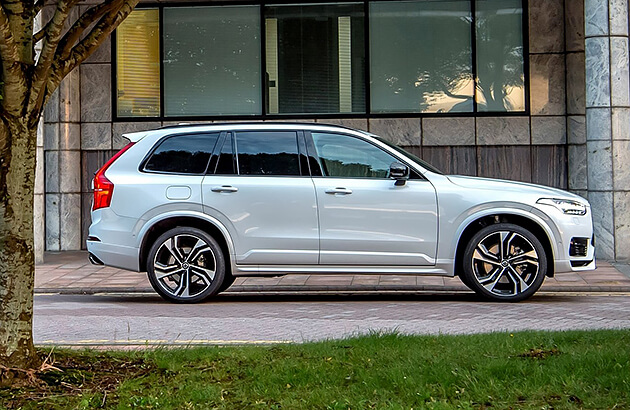
Volvo discontinued the small XC40 Recharge PHEV in Australia during mid-2022, but the midsized XC60 and ageing XC90 full-sized version continue with worthwhile improvements moving forward.
Imported from Sweden rather than China (unlike Volvo’s other SUVs), the XC90 Recharge PHEV takes on the BMW X5 plug-in hybrid. It features a 2.0-litre supercharged and turbocharged four-cylinder petrol engine, plus an uprated electric motor to drive the rear wheels.
The result is a big seven-seater SUV with sports-car performance, racing to 100km/h from standstill in just 5.3 seconds. It steers and handles with ease, while air suspension soaks up the bumps admirably.
Volvo claims pure EV range is now 77km. That means the new, bigger battery will take longer to recharge, though. Expect up to eight hours plugged into a normal socket at home, or over four hours with an optional wall box/AC public charger. DC fast charging is not supported.
The XC90’s size and packaging are one of its biggest drawcards, with sumptuous seating for five (and a useable third row – even for adults), a big boot area, a distinctly designed dashboard featuring lots of high-quality materials and industry-leading safety features.
It may be getting on, but the current XC90 PHEV’s tech is bang up to date.
| Engine: | 233kW/400Nm 2.0L in-line 4 turbo/supercharged petrol |
|---|---|
| Transmission/driving wheels: | 8-speed auto/AWD |
| Motor: | 107W/309Nm AC synchronous electric |
| Battery: | 18.8kWh Lithium-ion |
| Total system power/torque: | 339kW/709Nm |
| EV range: | 77km |
| Fuel: | 1.8L/100km |
| CO2: | 40g/km |
| Safety rating: | 5 stars |
BMW X5 xDrive45e PHEV AWD from $138,400 plus on-road costs
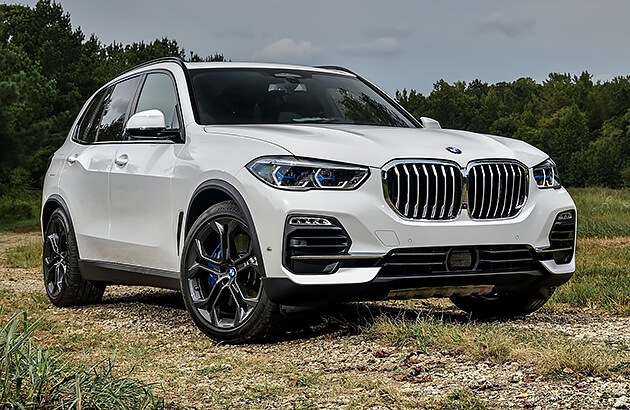
The X5 xDrive45e plug-in hybrid is the steppingstone to the completely unrelated full-electric iX, and sits above the normal petrol and diesel models also out of North America, but just below the high-performance V8-powered M50i.
BMW has been selling X5 PHEVs in Australia since 2015, but the latest version released in 2019 when the new-generation body was introduced swapped the old four-cylinder engine for a 3.0-litre six-cylinder unit.
As before, it is combined with an electric motor and battery pack, but the priority here is performance – as reflected in a very brisk 0-100km/h acceleration time of 5.6 seconds and 235km/h top speed. Not bad for a 2.5-tonne SUV.
The flipside is low pure-EV range. BMW says 77km is possible, but 40km is more achievable. Plugged in at home, up to 10 hours is needed to fully recharge, or about five hours with an optional wall box or using a public charger.
Otherwise, the xDrive45e is as per all modern X5s – big and spacious inside, with a high-quality interior offering large electronic displays, excellent seats, commanding views out and heaps of family-friendly practicality. The suspension keeps the ride soft, the steering is a joy to use, and at speed, the BMW feels fast and rock-solid secure.
| Engine: | 210kW/450Nm 3.0L in-line 6 turbo petrol |
|---|---|
| Transmission/driving wheels: | 8-speed auto/AWD |
| Motor: | 83kW AC synchronous electric |
| Battery: | 17kWh Lithium-ion |
| Total system power/torque: | 230kW/600Nm |
| EV range: | 77km* |
| Fuel: | 2.5L/100km |
| CO2: | 56g/km |
| Safety rating: | 5 stars |
* overseas data
Porsche Cayenne E-Hybrid AWD from $152,500 plus on-road costs
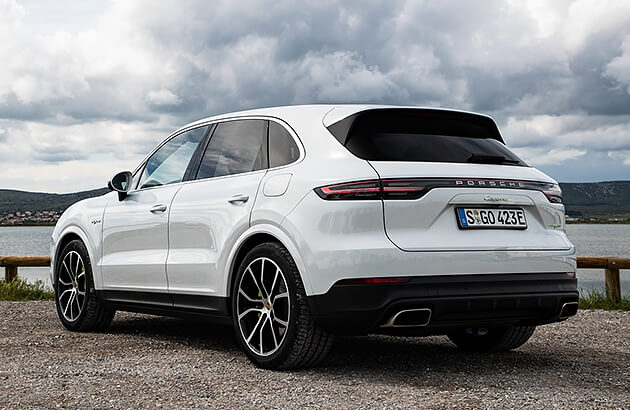
The cheapest Cayenne plug-in hybrid recently breached the $150K mark (rising to well over $300,000), but given its broad capabilities, even the base grade presents a compelling case.
Sharing the MLB Evo platform with other Volkswagen Group SUVs like the VW Touareg, Audi Q7 and Bentley Bentayga, the Cayenne looks and drives like a Porsche SUV should, offering outstanding speed, control and refinement.
Underneath there’s a 3.0-litre V6 turbo, automatic transmission, electric motor and battery pack, with drive oscillating seamlessly between pure EV (only for up to 47km, disappointingly) and petrol-electric hybrid muscle. Sports car performance is always on tap, with a 0-100km/h time of five seconds and 250km/h top speed.
Uniquely high ground clearance and a four-wheel drive system also allows for some light off-road capability.
Recharging using a household socket requires five hours, or three hours with an optional wall box. The Cayenne PHEV isn’t designed for DC fast chargers.
The interior feels rock-solid in its quality and presentation, while there’s a pleasing amount of space front and rear for most families’ needs. But, as with most Porsches, desirable luxuries are often very pricey, meaning an E-Hybrid’s price with a few choice options can blow out considerably.
Still, the Cayenne PHEV is both thrillingly and frugally athletic.
| Engine: | 250kW/450Nm 3.0L V6 turbo petrol |
|---|---|
| Transmission/driving wheels: | 8-speed auto/AWD |
| Motor: | 100kW/400Nm AC synchronous electric |
| Battery: | 17.9kWh lithium-ion |
| Total system power/torque: | 340kW/700Nm |
| EV range: | 47km |
| Fuel: | 3.2L/100km |
| CO2: | 73g/km |
| Safety rating: | N/A |
Last updated: July 2022
